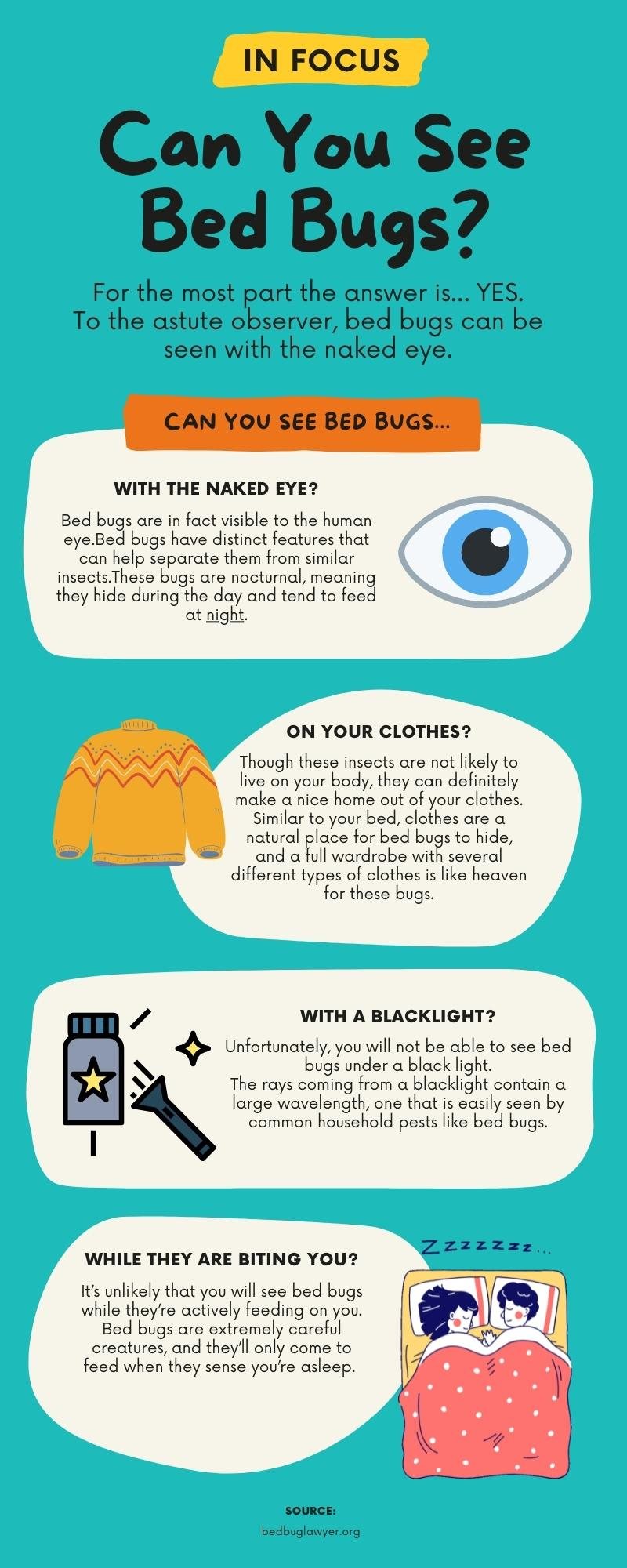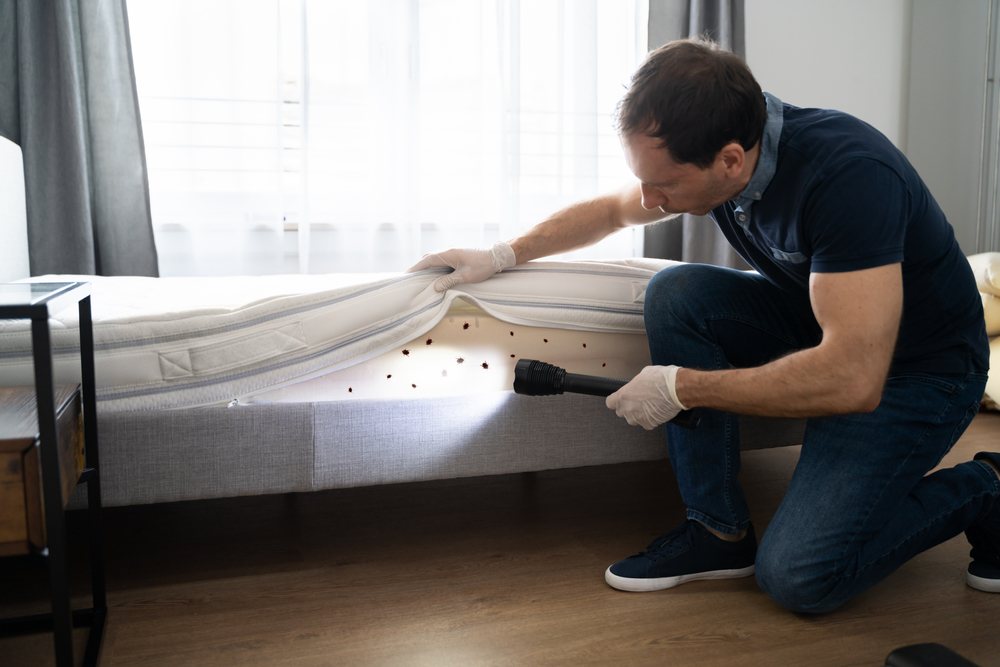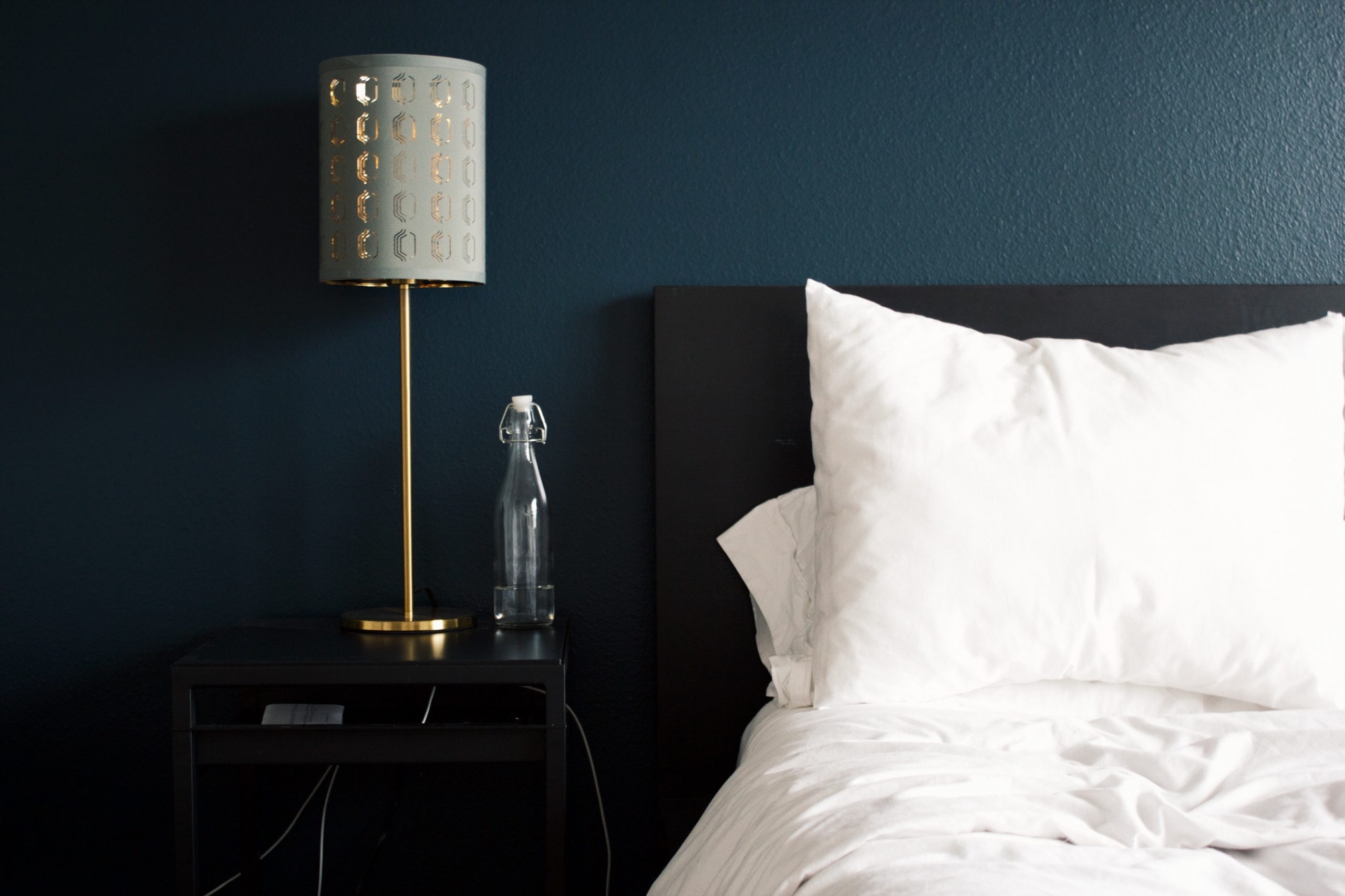They may be tiny… but bed bugs rarely go unnoticed for very long.
While most people find these creatures repulsing…
These insects are extraordinary in their ability to survive under difficult circumstances.
Bed bugs have unique anatomy with the ability to balloon to 3 times their normal size, alongside some aggressive feeding habits.
One of the best ways to prevent a bed bug infestation in your home is to quickly spot the creatures themselves.
The problem is that bed bugs have perfected the art of hiding (especially during the day).
This brings us to the question…
Are bed bugs visible to the human eye?
For the most part, the answer is… Yes.
To the astute observer, bed bugs can be seen with the naked eye.
Page Contents:
Can You See Bed Bugs?
Bed bugs have distinct features that can help separate them from similar insects.
These bugs are nocturnal, meaning they hide during the day and tend to feed at night.
Therefore, one tell-tale sign that the insects you’re seeing might not be bed bugs is:
If they’re very active during the daytime.
If you think you saw some bed bugs scurry by but you’re not entirely sure….
Let’s run through some of the ways to determine if the insects you’re witnessing are in fact bed bugs.
Here we will also differentiate between fed vs. unfed bed bugs, as well as adult vs. babies (nymphs).
Their Color:
Unfed adult bed bugs: Rusty brown color.
Fed adult bed bugs: Typically, a more reddish brown.
Nymphs: Off-white, nearly colorless.
Their Shape:
Unfed adult bed bugs: flat and oval.
Fed adult bed bugs: Round and swollen, they also become more elongated.
Nymphs: flat and extremely small.
Their Size:
Adult bed bugs: About ¼ inch
Nymphs: Anywhere from 1 to 5 mm long (1/20th of an inch)
The biology of these creatures includes a beak with 3 segments. They produce a musty-sweet odor through glands that are across the lower side of their body.
Knowing what to look for is the first step in controlling bed bugs, especially to avoid costly treatment of the wrong insect.
What Do Bed Bugs Look Like on a Mattress?
Detecting bed bugs or evidence of bed bugs on your mattress is an integral step in properly identifying an infestation.
If you spot insects on your mattress, use the information above to determine whether these creatures are in fact bed bugs.
If you’re experiencing bites or other symptoms of an infestation, but haven’t seen any physical bed bugs:
You should look for signs of an infestation.
Take the following steps to detect evidence of an infestation on your mattress:
- Using a flashlight and a stiff-edged object like a credit card, check around the mattress, box spring, headboard, and bed frame.
- Inspect bedding and sheets for blood spots or fecal stains.
- Check around the seams, tufts, and folds of your mattress thoroughly
- With the flashlight, check under the bed and around corners/crevices.
- DO NOT miss any spots! A thorough careful investigation is important here.
Even one missed bed bug can make the difference in whether an infestation grows or doesn’t.
Though mattresses are the most common places bed bugs live.
(Because it’s warm and near their food source).
Don’t forget to check other unexpected areas of your home for bed bugs.
Can You See Bed Bugs on Clothes?
Though these insects are not likely to live on your body, they can definitely make a nice home out of your clothes.
Similar to your bed, clothes are a natural place for bed bugs to hide, and a full wardrobe with several different types of clothes is like heaven for these bugs.
So the short answer is Yes….
You can see bed bugs on your clothes.
If your clothes are darker, bed bugs are harder to spot since there is little to no color contrast between the clothes and the insect’s body.

Though with brighter clothing…
Bed bugs are easy to spot.
How do You Get Bed Bugs out of Your Clothes?
The way to remove bed bugs from your clothing is through heat.
Since these insects are cold-blooded animals, they can survive quite well in the cold, but can not survive temperatures above 120 degrees Fahrenheit for very long.
Step 1: Sort Your Clothes
Upon detecting an infestation, sort your clothes by color.
Seal the sorted piles in plastic bags tightly.
Make sure you have a proper seal.
(You don’t want bed bugs flying out while you walk clothes to the laundry).
Step 2: Washing and Drying
Set the washing temperature to its highest setting.
An added benefit is extreme heat will remove the musty smell bed bugs can add to your clothes.
Then put your clothes in the dryer on the highest setting (for at least an hour).
Step 3: Spray Your Wardrobe
Next, you’ll need to treat your wardrobe.
Use an approved bed bug insecticide and spray around your wardrobe or closet.
Note – The EPA, has a list of over 300 products that are considered safe for treating bed bugs.
Step 4: Vacuum Your Clothes
Lay your clothes out neatly, and then slowly vacuum every part of your clothing.
Look out for residue or dead bugs, and fold all clothes in a separate pile when finished.
You may then store your clothes back in your wardrobe or closet.
(After it has been properly sprayed).
If you believe bed bugs have infested areas beyond your clothes, consider getting a professional heat treatment, to treat your entire home for bed bugs.
Can Bed Bugs Affect Your Eyes?
There are rumors out there that bed bugs can affect your eyesight.
or to even cause you to go blind….
This is entirely false.
Other than a rare circumstance where the bite causes an adverse reaction (likely due to a preexisting condition), bed bugs will not affect your eyes.

Bed bugs have no interest in your eyes, they’re looking for a surface of your skin where they can comfortably drink your blood for 10 minutes.
In most cases, bed bugs do not cause long-term physical damage, and aren’t typically vectors for pathogens.
This is not to dampen the level of pain and suffering a bed bug infestation can cause, but usually this suffering is more psychological damage than anything else.
Can You See Bed Bugs With a Blacklight?
Unfortunately, you will not be able to see bed bugs under a black light.
The rays coming from a blacklight contain a large wavelength, one that is easily seen by common household pests like bed bugs. So if you try and shine a black light on them, bed bugs will immediately run back into hiding.
That being said, blacklight technology might still be useful in detecting an active infestation in your house.
A blacklight can be used to help identify common bed bug signs, whether it be shed skin, a trail of excrement, or bed bug eggs.
Before you search a room for signs of an infestation, you should make the necessary preparations.
This includes going through the following steps:
Step 1 – Clear out any clutter from the room.
Step 2 – Move furniture to the center of the room so that you can more easily move around.
Step 3 – Put on blue latex gloves before feeling around potentially infested furniture (the blue color also provides a nice color contrast that helps with easy detection.
Can You See Bed Bugs Crawling?
Yes, you can certainly see bed bugs crawling if you suspect an infestation in your home. Though if you don’t see bed bugs crawling around, that doesn’t necessarily mean you “don’t” have an infestation.
Bed bugs stay away from the daylight and tend to only travel at night, so you typically won’t see bed bugs outside of their hiding place.
(Unless you’re experiencing an extremely severe infestation).
If you do notice bed bugs crawling around during the day, you should call a local bed bug expert ASAP!
Can You See Bed Bugs Biting You?
It’s unlikely that you will see bed bugs while they’re actively feeding on you. Bed bugs are extremely careful creatures, and they’ll only come to feed when they sense you’re asleep.
Bed bugs also inject an anesthetic into your skin to slightly numb the area that they’re feeding on. This is why you don’t “feel” the bed bug as they’re actively biting you.
Note – The common bed bug will bite you for an average of 10 minutes or so before it’s fully engorged with your blood.
So How Did You Get Bed Bugs in the First Place?
Determining the origin of a known bed bug infestation is not an easy task. Bed bugs are known for their ability to hitchhike on almost anything.
This could be clothes, belongings, furniture, luggage, etc…
With the increase in traveling and population, bed bugs are spreading more than ever.
A few obvious situations where bed bugs might have come from are:
Used Furniture:
If you recently purchased a piece of used furniture, the infestation could have originated at the furniture store.
Your Neighbors:
If you live in a multi-unit apartment complex, it’s likely that your neighbor had an infestation that then spread through the walls into your apartment.
Infestations like that often lead to tenant-landlord disputes where the tenant may have a right to compensation for damages.

Your Clothes or Handbag:
If you were recently in a big crowd, whether it be at a sporting event, concert venue, or movie theater.
It’s likely bed bugs attached themselves to you during that period.
How to Identify Bed Bugs Outside of the Bedroom
To sum up, bed bugs, like many other household pests, are large enough to spot with the human eye.
Adult bed bugs will grow to about the size of an apple seed and will be dark brown in color.
If you don’t spot any bed bugs, you may be able to see their shed skin, which is lighter brown and translucent.
Bed bug eggs may also be present, which, although smaller than adult bed bugs, are still visible and resemble grains of rice.
Even if you can’t see physical bed bugs…..
You can look for the evidence that bed bugs leave behind.
This could include rust-colored fecal smears or spots, or simply their bites on your skin.
Which often cause irritation, and appear in clusters or lines of red bumps.
Where to Look for Bed Bugs
If you believe bed bugs are present in your home or your hotel room, there are certain places to check for evidence of infestations.
First, check inside the bed, including bedsheets, behind headboards, in mattress seams, and around the box spring.
If you don’t spot bed bugs or any evidence of their existence but still suspect an infestation is present…..
You should contact an exterminator for professional services to help identify and eliminate these pests.
Taking the correct steps to identify and prevent bed bug infestations can help ensure that you and your family remain safe from any potential problems in the future.
Do You Have a Right to Compensation?
If you or a loved one were infested by bed bugs in your apartment, hotel room, or Airbnb, you may have a right to financial compensation.
To learn more…
Get connected with an attorney for your free consultation today!
Summary (Infographic)






My home received 3 treatments by an exterminator. The last was Sept 11th. Throughout the treatments I continued to be bitten and am still finding bites all over. I was guaranteed one more treatment if the bugs were still present but the exterminator refuses to do it. He says there are no bugs. He has blamed the bites on everything from gnats to scabies. They are the same exact bites he earlier confirmed as bed bug bites. The look feel the same and are located on the same areas of the body. He made it clear his services aren’t longer available to me. I dont know what to do. Can you help?